“Devi (Goddess) Chariot Panel” has been added to your cart.
View cart
-
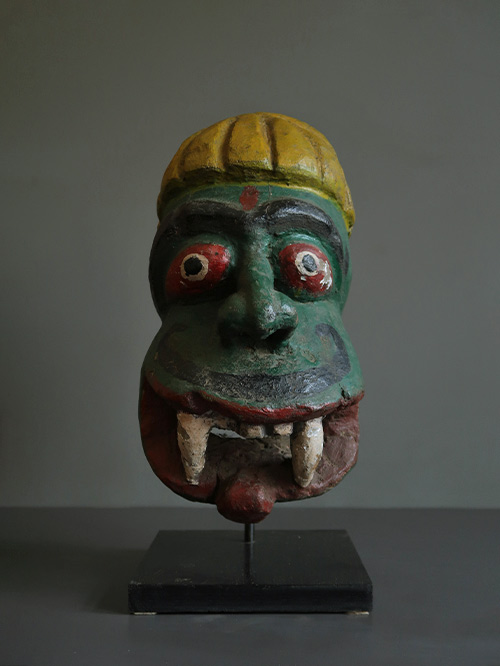
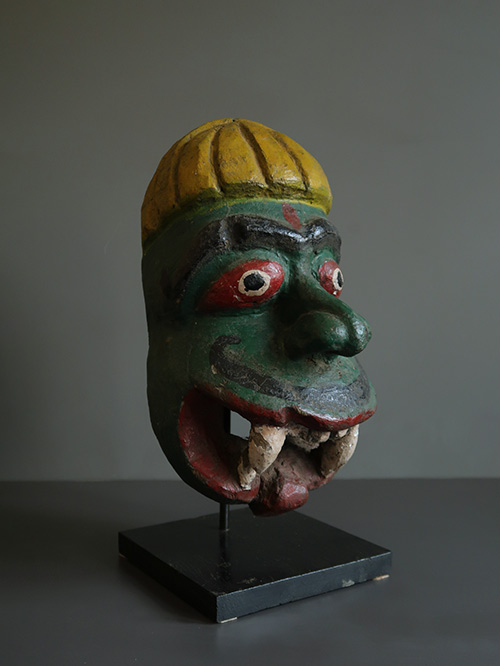
Maharashtra
wood, polychromed
Masks are very popular among the Kukanas and the Warlis of Gujarat and Maharashtra. They are used on ceremonial occasions when dramas are performed to the accompaniment of music and dance. During the festivals of Holi and Diwali mask-shows are organised by itinerant tribal artists in different villages. They serve the purpose of tribal unity and stability and to inculcate respect for tribal traditions and ancestors. When wearing a mask, the tribal artist first decides on the size of the mask—generally larger than the human face— and the fills in details. Painting on the mask is done not as part of the enrichment of the sculpture, but as a means by which the spirit is infused into the mask and thus it comes to life. Traditionally, masks were created out of fear of the natural power around them. People copied the world of animals and birds through symbols, paintings and sketches around them. The fear of the dynamism of nature within and outside, propelled them to create mask as a linkage between his world and the one unknown to him. Masks were treated as instruments of revelations- a pathway to the world of gods and other invisible powers- by giving form to the formless.
Mask Size (cms): 37 (H) x 18 (W) x 22 (D), 45 (H with stand)
Mask Size (inches): 14.6 (H) x 7 (W) x 8.7 (D), 17.7 (H with stand)
-
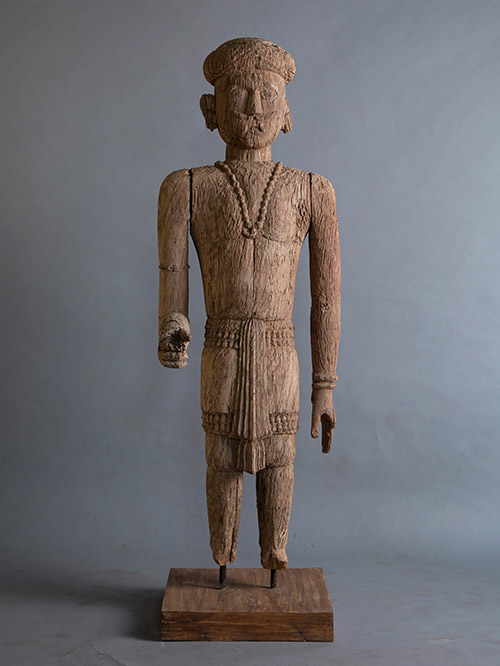

Coastal Karnataka (Bhuta culture)
Wood
A rare figure of a male donor chief. He wears a turban, has a prominent moustache and is decked with typical jewellery including a single strand necklace with a pendant, armlet and earrings. He wears an unstitched garment tied at the waist with pleats at the front, called a mundu.
The bhuta tradition is popular on the Malabar coast. Bounded by the dramatic sweep of the forested ghats to the east and the Arabian sea to the west, and encircled by rivers, the South Kanara district of coastal Karnataka has enjoyed relative geographic isolation until recent years. This has enabled the region to retain specific pre-Hindu belief systems and associated rituals, virtually intact, over several hundred years. These practices have a distinct identity of their own, although they have become linked in a variety of ways with mainstream Hinduism. Though now primarily confined to Coastal Karnataka, Bhuta cults once existed all over India under different names and forms. The factions, which are of considerable antiquity, have much in common with those of the yakshas (mysterious semi-divine beings), for instance.
Size (cms): 147(H) x 44(W) x 54(D)
Size (inches): 58(H) x 17.5(W) x 21.5(D)
-
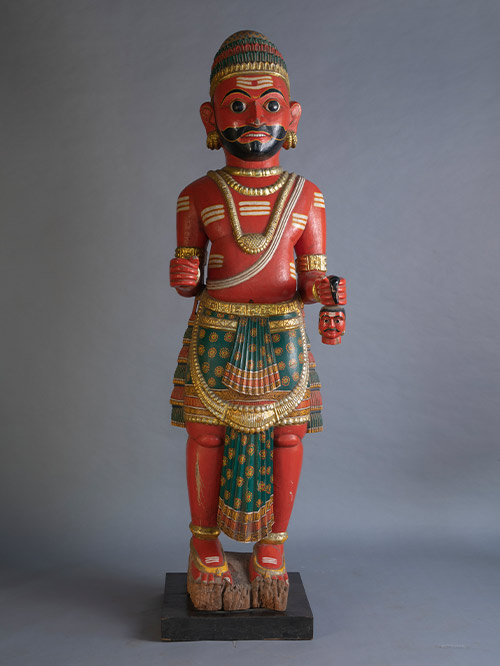
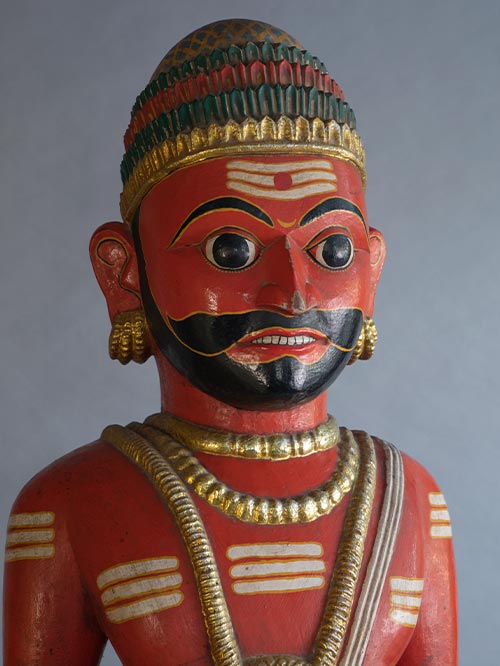
Coastal Karnataka (Bhuta culture)
Wood
A rare figure of a Virabhadra in the form of a Bhuta. He wears a turban, has a prominent moustache and beard and is decked with typical jewellery including a single strand necklace with a pendant, armlet and earrings. He wears an unstitched garment tied at the waist with pleats at the front, called a mundu. He carries in one hand the head of a slain enemy and in the other, he would have held a sword.
The bhuta tradition is popular on the Malabar coast. Bounded by the dramatic sweep of the forested ghats to the east and the Arabian sea to the west, and encircled by rivers, the South Kanara district of coastal Karnataka has enjoyed relative geographic isolation until recent years. This has enabled the region to retain specific pre-Hindu belief systems and associated rituals, virtually intact, over several hundred years. These practices have a distinct identity of their own, although they have become linked in a variety of ways with mainstream Hinduism. Though now primarily confined to Coastal Karnataka, Bhuta cults once existed all over India under different names and forms.
Size (cms): 188(H) x 56(W) x 56(D)
Size (inches): 74(H) x 22(W) x 22(D)
-
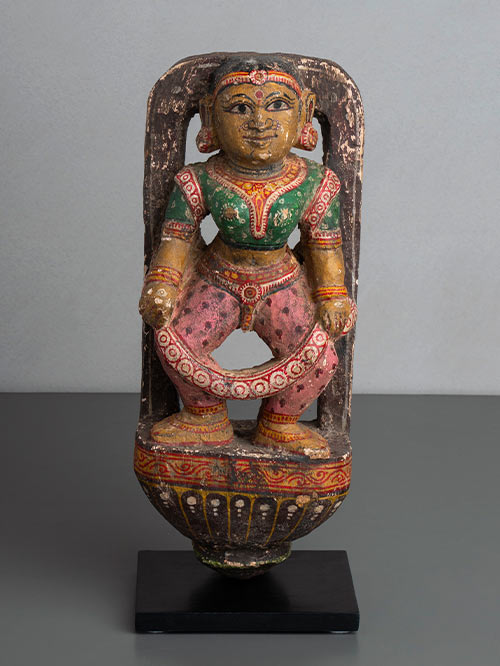
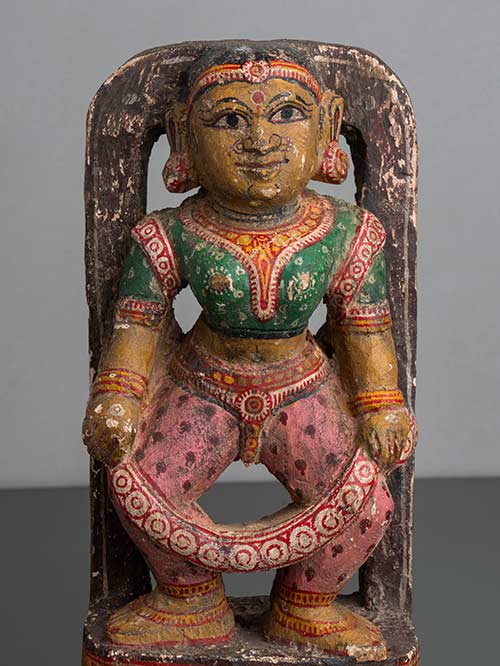
Orissa
Wood, polychromed
An elegant figure of an apsara wearing a patterned blouse. The apsara is adorned with extensive jewelry, including multiple hand and leg ornaments. She has a stylised form with a narrow waist and large breasts, and she holds a floral garland in front of her. Her full face features a pronounced chin, large arched eyebrows over bulbous eyes, and a gentle smile.
Apsaras means ‘essence of the waters’ or ‘moving in or between the waters’. The Apsaras are divine beauties, the dancers of the gods, who dwell in Indra’s paradise, svarga (heaven). Mistresses of the Gandharva’s (semi divine beings) and, occasionally, of men, they can assume any form at will. Generally they are believed to have originated from the churning of the ocean, alone with the wish fulfilling Parijata, their favoured tree. They are often sent by the gods to seduce Rishis (holy men) and ascetics. Heroes who fall in battle are swept away to Svarga by the Apsaras. They are reputed to dwell in trees along with the Gandharvas. The chief of the Apsaras is Urvashi.
Size (cms): 33.5(H) x 13(W) x 10(D)
Size (inches): 13(H) x 5(W) x 4(D)
-

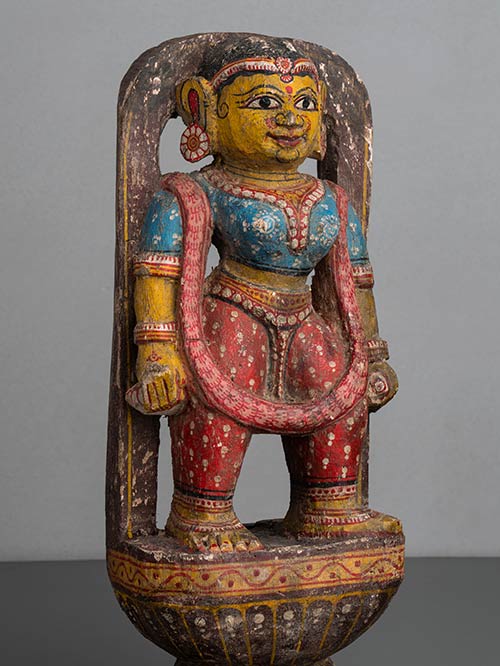
Orissa
Wood, polychromed
An elegant figure of an apsara wearing a patterned blouse. The apsara wears extensive jewellery; including multiple hand and leg ornaments. She has a stylised form with a narrow waist and large breasts and carries a conch in either hand. She has a full face with a pronounced chin, large arched eyebrows over bulbous eyes and a gentle smile.
Apsaras means ‘essence of the waters’ or ‘moving in or between the waters’. The Apsaras are divine beauties, the dancers of the gods, who dwell in Indra’s paradise, svarga (heaven). Mistresses of the Gandharva’s (semi divine beings) and, occasionally, of men, they can assume any form at will. Generally they are believed to have originated from the churning of the ocean, alone with the wish fulfilling Parijata, their favoured tree. They are often sent by the gods to seduce Rishis (holy men) and ascetics. Heroes who fall in battle are swept away to Svarga by the Apsaras. They are reputed to dwell in trees along with the Gandharvas. The chief of the Apsaras is Urvashi.
Size (cms): 33.5(H) x 13(W) x 10(D)
Size (inches): 13(H) x 5(W) x 4(D)
-
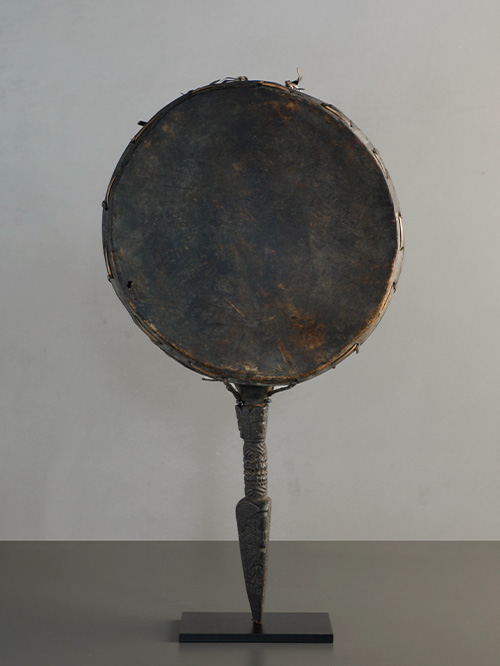
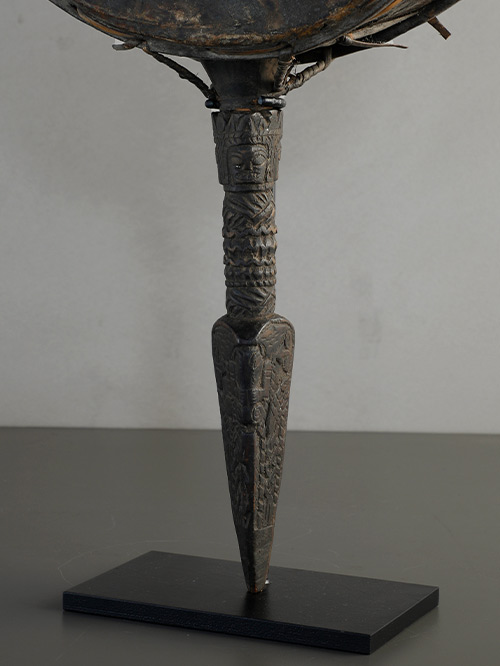
Nepal
Wood, hide and cane
The dhyangro is a double-headed frame drum used by jhakris (tribal shamans), especially those of the Magars, the Kirati, and the Tamang, in the Middle Hills region of the Himalayas in Nepal. It is considered an ancient tool of magic and has been used by shamans for centuries to enter a trance and channel benevolent helping deities. The drum is played by holding the handle in the left hand, with the frame level with the face, and striking the outer head with the right hand holding a curved stick.
The drum has hide drumheads stretched over a circular wooden rim, secured with rattan strips. The handle is elongated and carved to resemble a phurba or esoteric dagger found in Tibetan Buddhist ritual. The handle features ornate relief carving depicting three deity heads and many shamanistic symbols, such as endless knots and caduceus-like symbols, that encircle it.
Size (cms): 65(H) x 35(W) x 14(D)
Size (inches): 25.5(H) x 14(W) x 5.5(D)
-
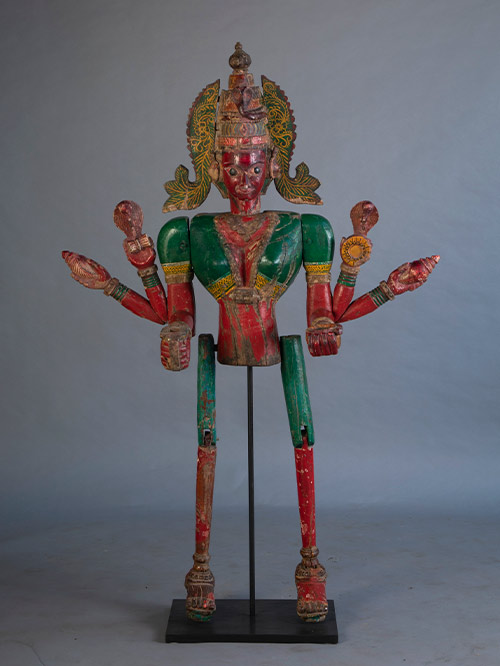
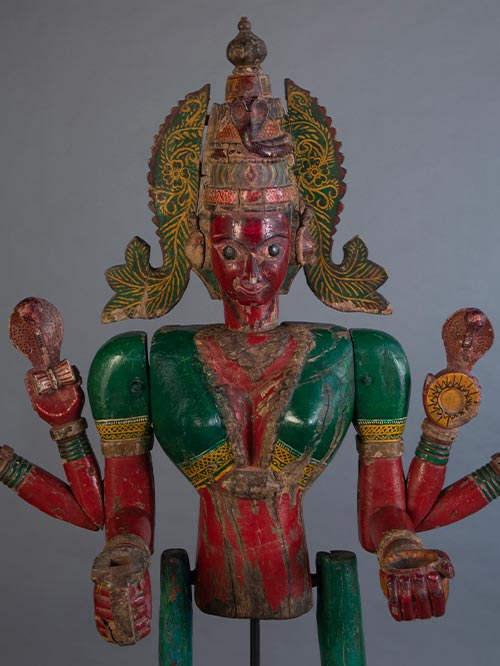
Karnataka
Wood, polychromed
An attractive multi-armed articulated standing figure of the Goddess Durga. Painted in a deep red, she wears a patterned green and yellow blouse. Her hands are adorned with multiple bangles and she carries a pair of nagas and conches in her upper hands with a blood bowl and sword in her lower two hands. An elaborate tiered crown sits on her head, decorated with geometric symbols and a serpent (naga).
Durga – “The Unconquerable form of Devi” – Durga is the most splendid manifestation of Devi. Virginal and sublime, contain within her the power of all the gods combined, she is the invincible power of Nature who triumphs over those who seek to subjugate her.
Size (cms): 132(H) x 88(W) x 31(D)
Size (inches): 52(H) x 34.5(W) x 12(D)
-
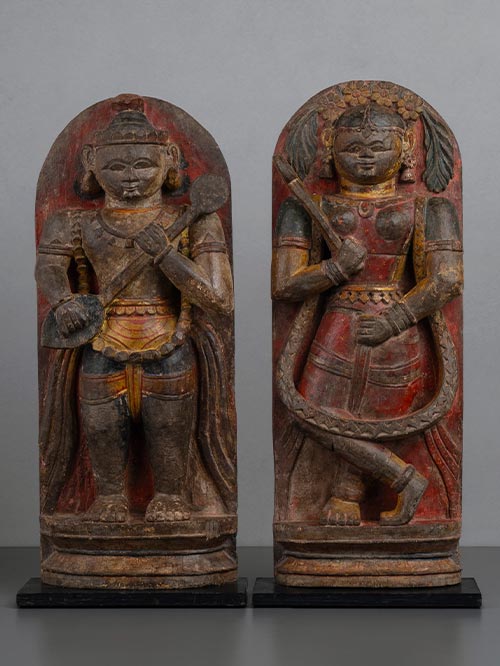
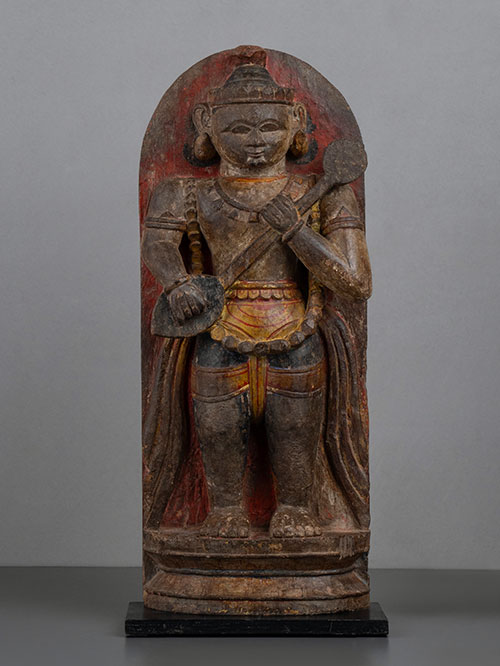
Orissa
Wood, polychromed
This beautiful pair of richly polychromed brackets depicts a musician carrying a string instrument and an attendant figure holding a chauri (fly-whisk). Standing on stepped bases, both figures are adorned with rich garments and wear long floral garlands. These figures likely originated from a natamandir, an addition to the shrine often adorned with sculptures of Devadasis and musicians.
Size (cms): 50(H) x 21(W) x 10(D)
Size (inches): 19.5(H) x 8.5(W) x 4(D)
-

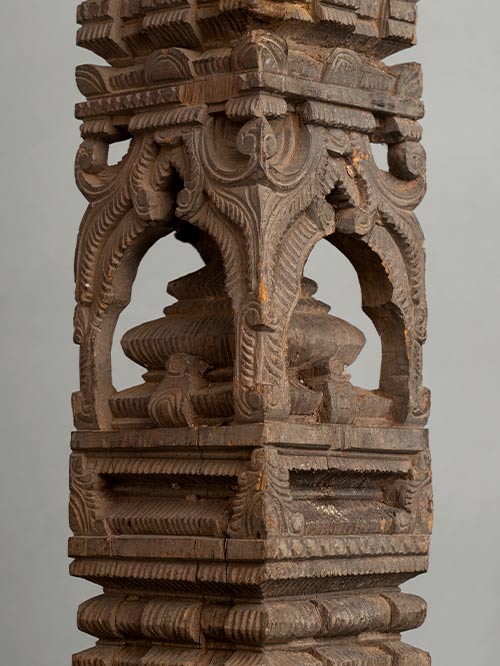
Tamil Nadu
Wood
An attractive candlestand which is unusually inspired by the temple pillars found in traditional Indian temples.
Indian temple pillars exhibit a rich diversity of designs, styles, and intricate carvings that reflect the cultural and artistic heritage of the country. Different regions and time periods in India have produced distinct styles of temple architecture, and the pillars play a significant role in supporting the temple structures while also serving as platforms for artistic expression. The design of these pillars was influenced by architectural styles such as the Nagara and Dravidian, with careful consideration given to structural engineering principles, mathematical precision, and adherence to Vastu Shastra.
Size (cms): 38(H) x 12(W) x 12(D)
Size (inches): 15(H) x 4.5(W) x 4.5(D)
-
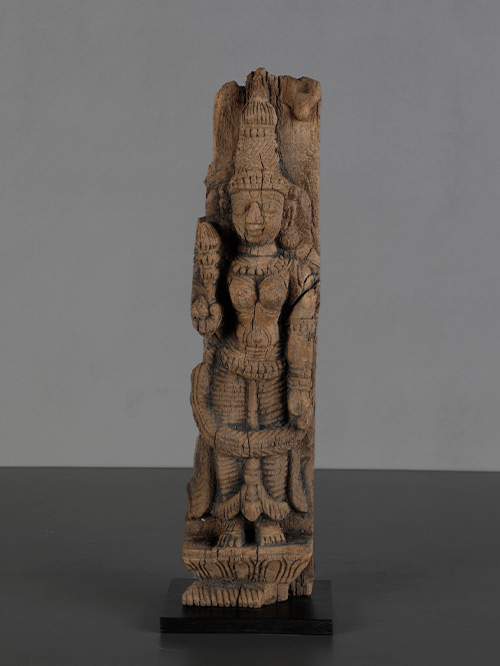

Tamil Nadu
Wood
Maha Devi or the Great Goddess was the female energy of Shiva. The Devis are generally seen as wives of the gods or river goddesses. In the post Vedic era, the generic term Devi assumed a new meaning, designating the great goddess ie Shiva’s cosmic energy (Shakti), the essence of all things. The concept of Devi developed over a long period of time, in which many local fertility and nature goddesses were absorbed into the Shaiva tradition to constitute Devi’s many facets. Bountiful goddesses, such as Parvati and Gauri, and destructive deities, such as Durga and Kali, merged into her complex personality, but despite their different names and functions, each of them is Devi, and she in turn represents their totality.
Chariots of Tamil Nadu, locally called ter, are intricate wooden structures of monumental size. The lower portion of the chariots are completely covered with timber panels carved with a wide range of figural and animal sculptures. These friezes, which constitute the finest wooden sculptures in the region, can be viewed only during the chariot festival; for the remainder of the year the chariots are parked in shelters to protect them from the sun and rain.
Size (cms): 43(H) x 13(W) x 10(D)
Size (inches): 17(H) x 5(W) x 4(D)
-
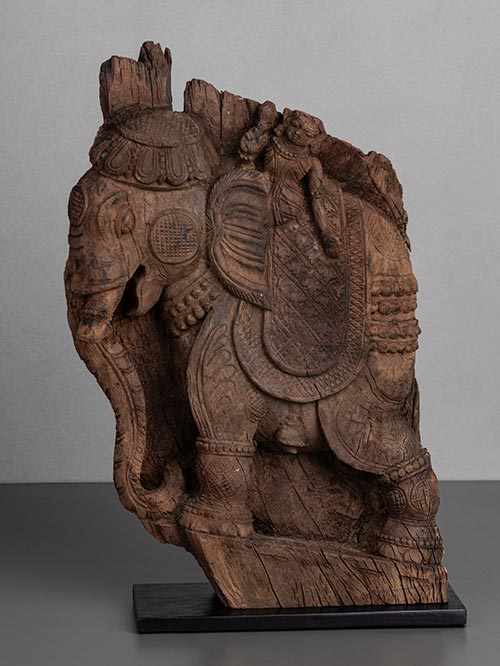

Tamil Nadu
Wood
A finely detailed chariot panel of caparisoned elephant with a mahout holding a chauri (fly-whisk).
The elephant is an auspicious symbol in Indian and Southeast Asian cultures, embodying cosmic splendor and fertility. In mythology, Indra’s divine mount Airavata emerged from the ocean during its churning, linking elephants to life-giving rains. Revered in Buddhism as well, Siddhartha was conceived as a white elephant, and the welfare of elephants remained central to Indian rulers, including the Mughals.
Chariots of Tamil Nadu, locally called ter, are intricate wooden structures of monumental size. The lower portion of the chariots are completely covered with timber panels carved with a wide range of figural and animal sculptures. These friezes, which constitute the finest wooden sculptures in the region, can be viewed only during the chariot festival; for the remainder of the year the chariots are parked in shelters to protect them from the sun and rain.
Size (cms): 45(H) x 32(W) x 10(D)
Size (inches): 17.5(H) x 12.5(W) x 4(D)
-
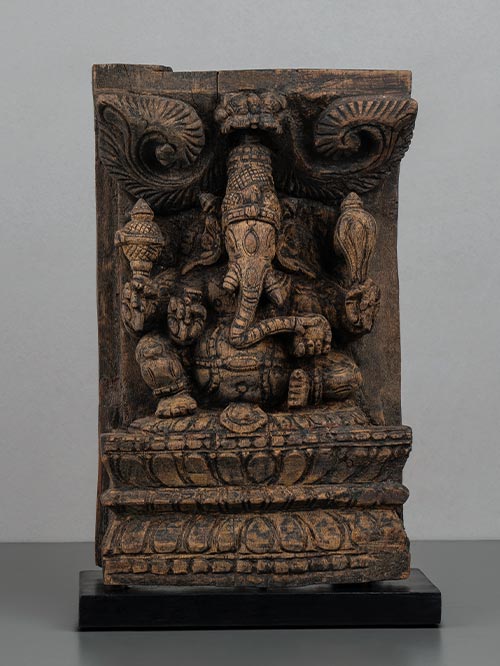
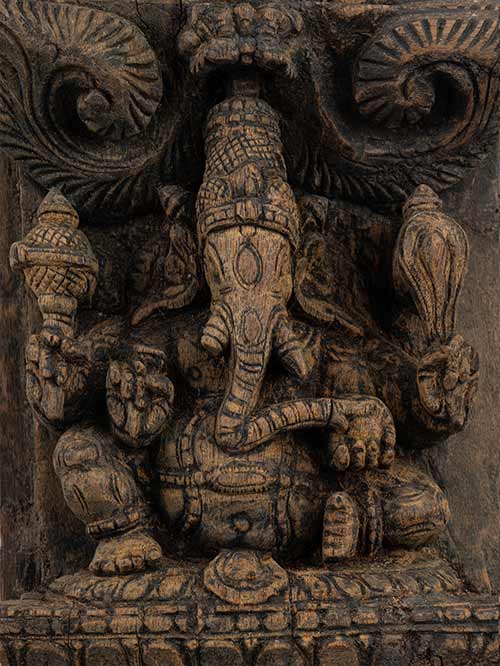
Tamil Nadu
Wood
A decorative carved panel with a central figure of a four-armed Ganesha seated atop a double lotus base in Padmasana (lotus posture), with one leg folded up and the other resting on the ground. The leg on the ground symbolises his connection to the earthly realm while the other is rooted in single-pointed concentration upon supreme reality. He holds a pasha noose in his upper left hand and an ankusa (mace) in his upper right. His broken tusk is gripped within his lower right hand and in his lower left, he holds his characteristic sweet modaka (sweet rice or wheat cake) and is depicted eating the modaka with his trunk. Ganesha’s fondness of modak can be traced back to his childhood. A winged kirtimukha (face of glory) forms a stylised prabhavali above deity.
Chariots of Tamil Nadu, locally called ter, are intricate wooden structures of monumental size. The lower portion of the chariots are completely covered with timber panels carved with a wide range of figural and animal sculptures. These friezes, which constitute the finest wooden sculptures in the region, can be viewed only during the chariot festival; for the remainder of the year the chariots are parked in shelters to protect them from the sun and rain.
Size (cms): 33.5(H) x 21.5(W) x 11(D)
Size (inches): 13(H) x 8.5(W) x 4.5(D)
-
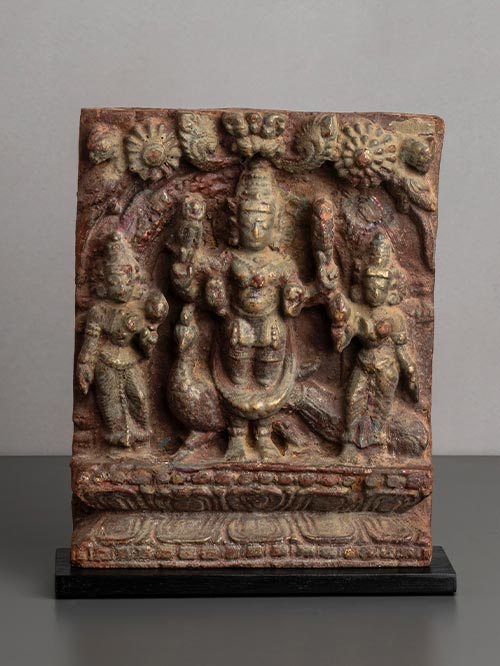
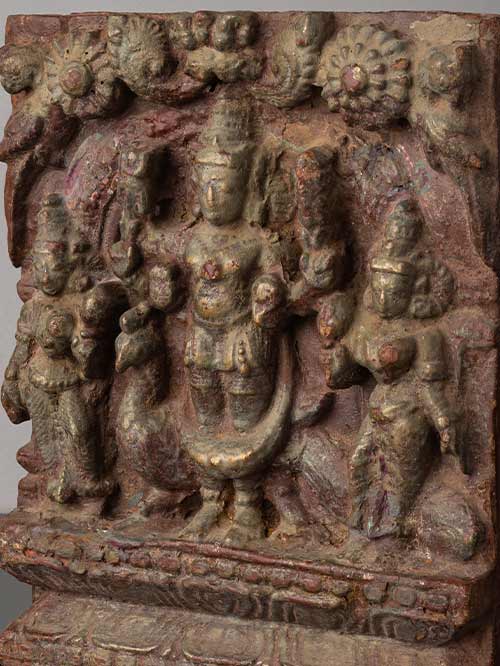
Tamil Nadu
Wood with traces of polychroming
A decorative, small chariot panel depicting Kartikeya (also known as Subrahmanyam, Murugan or Skanda). His consorts Devasena and Valli stand on either side and his peacock vahana stands by his feet. A prabhavali topped by a kirtimukha (face of glory) surrounds the deity.
Karttikeya is the god of war and ruler of the planet Mars. Generally thought of as the son of Shiva and Parvati. He is shown riding or standing near his peacock, a symbol of immortality, carrying various weapons, such as a club, battle-axe and chisel, and his typical weapon, the spear.
Chariots of Tamil Nadu, locally called ter, are intricate wooden structures of monumental size. The lower portion of the chariots are completely covered with timber panels carved with a wide range of figural and animal sculptures. These friezes, which constitute the finest wooden sculptures in the region, can be viewed only during the chariot festival; for the remainder of the year the chariots are parked in shelters to protect them from the sun and rain.
Size (cms): 29(H) x 34(W) x 8.5(D)
Size (inches): 11.5(H) x 13.5(W) x 3.5(D)
-
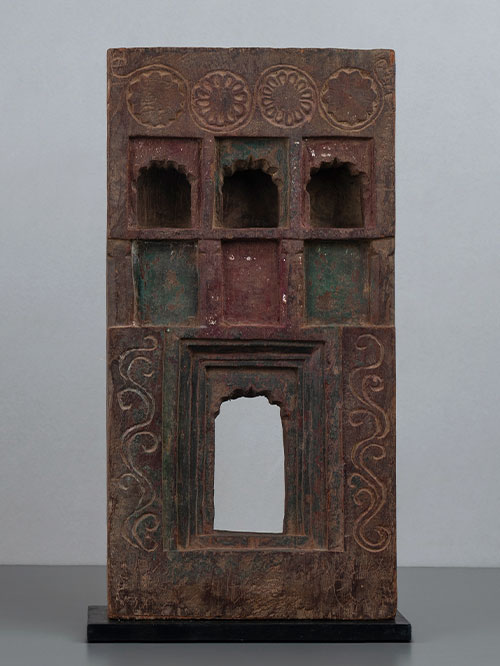
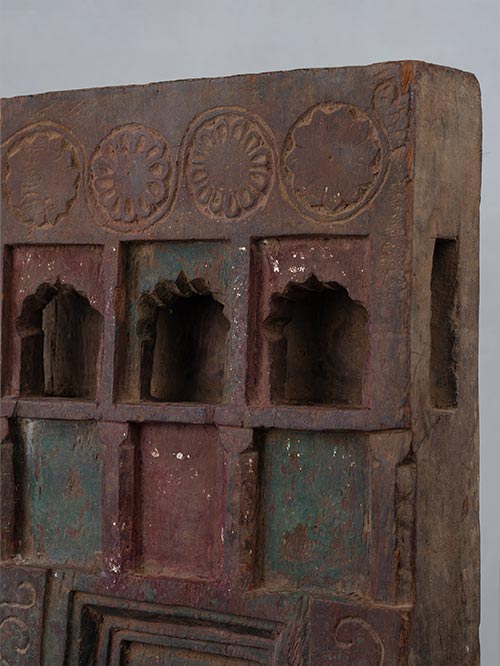
Deccan
Wood with polychroming
A lovely miniature window in the shape of an entrance gateway to a building. The window uses an eclectic mix of Indic and Islamic architectural elements such as the multiple sakhas (door jambs) traditionally found in North Indian Temple architecture. Above the door, the upper story is decorated with jharokas which are painted in alternating red and green. Floral swirls and geometric roundels surround the architectural elements of this charming panel.
Size (cms): 40.5(H) x 20.5(W) x 6(D)
Size (inches): 16(H) x 8(W) x 2.5(D)
-
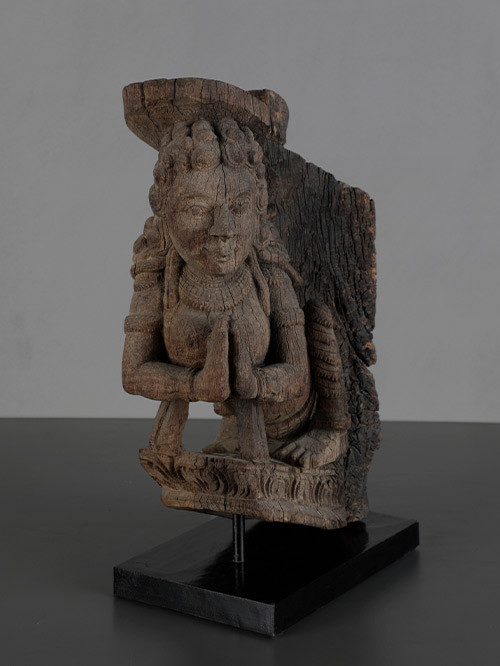

Tamil Nadu
Wood
A fine and rare Chariot chariot panels of Mohini, the enchantress. Finely detailed, Mohini wears elaborate jewellery and her hair is in curled locks displaying a markedly European influence. She is depicted kneeling with her hands folded in anjali mudra. Remnants of the supporting wooden tenons are still attached.
Mohini is the only female avatar of the Hindu god Vishnu. She is portrayed as a femme fatale, an enchantress, who maddens lovers, sometimes leading them to their doom. Mohini is introduced into the Hindu theology in the narrative epic of the Mahabharata. Here, she appears as a form of Vishnu, acquires the pot of Amrita (an elixir of immortality) from thieving asuras (demons), and gives it back to the devas (gods), helping them retain their immortality.
Chariots of Tamil Nadu, locally called ter, are intricate wooden structures of monumental size. The lower portion of the chariots are completely covered with timber panels carved with a wide range of figural and animal sculptures. These friezes, which constitute the finest wooden sculptures in the region, can be viewed only during the chariot festival; for the remainder of the year the chariots are parked in shelters to protect them from the sun and rain.
Size (cms): 40(H) x 23(W) x 15(D)
Size (inches): 15.5(H) x 9(W) x 6(D)
-

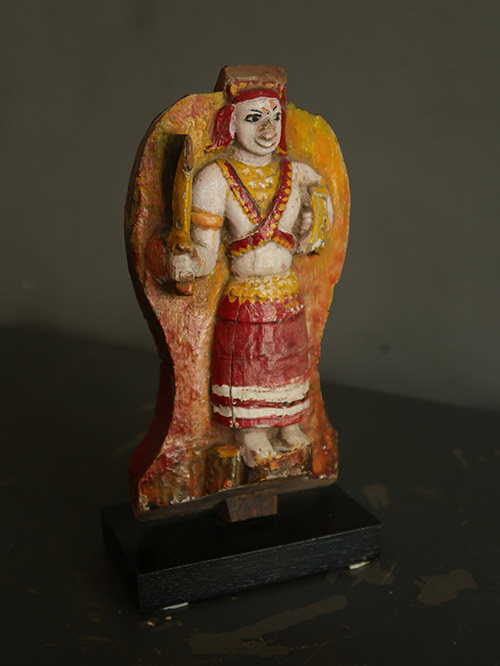
Northern Kerala (South India)
polychromed Wood
A finely carved panel depicting Karim Kutty Sasthan.
Karim Kutty Sasthan is one of the five so-called “magical” deities. He is a deity whose ambiguous and complex myth describes him as the unruly son of a Brahmin exorcist. After his father savagely beats him for sacrificing a favourite red bull, the boy leaves home and goes on a bloodthirsty rampage. Despite this seemingly ungodly behaviour, he is a mysterious god of tremendous powers possessing the attributes of both Lord Shiva and Lord Vishnu.
Theyyam is the ancient Malabar performance-ritual in which empowered men, after suitable mental, physical and spiritual preparations ‘become’ the deities. Wearing spectacular costumes and headdresses and with their human features hidden behind mask-like make-up, they enter the shrine’s precincts to make the final transference from one state of consciousness to another. The defining moment comes when they gaze into a mirror and see not their own made-up face but a reflection of the deity. Once this line has been crossed, devotees can directly approach, honour and question a deity belonging to an extraordinary pantheon of divine beings, consisting not only of gods and goddesses but deified ancestors, warrior heroes, animals, ghosts and spirits.
Size(cms): 26.5 (H) x 13,5 (W)
Size(inches): 10.5 (H) x 5 (W)

































